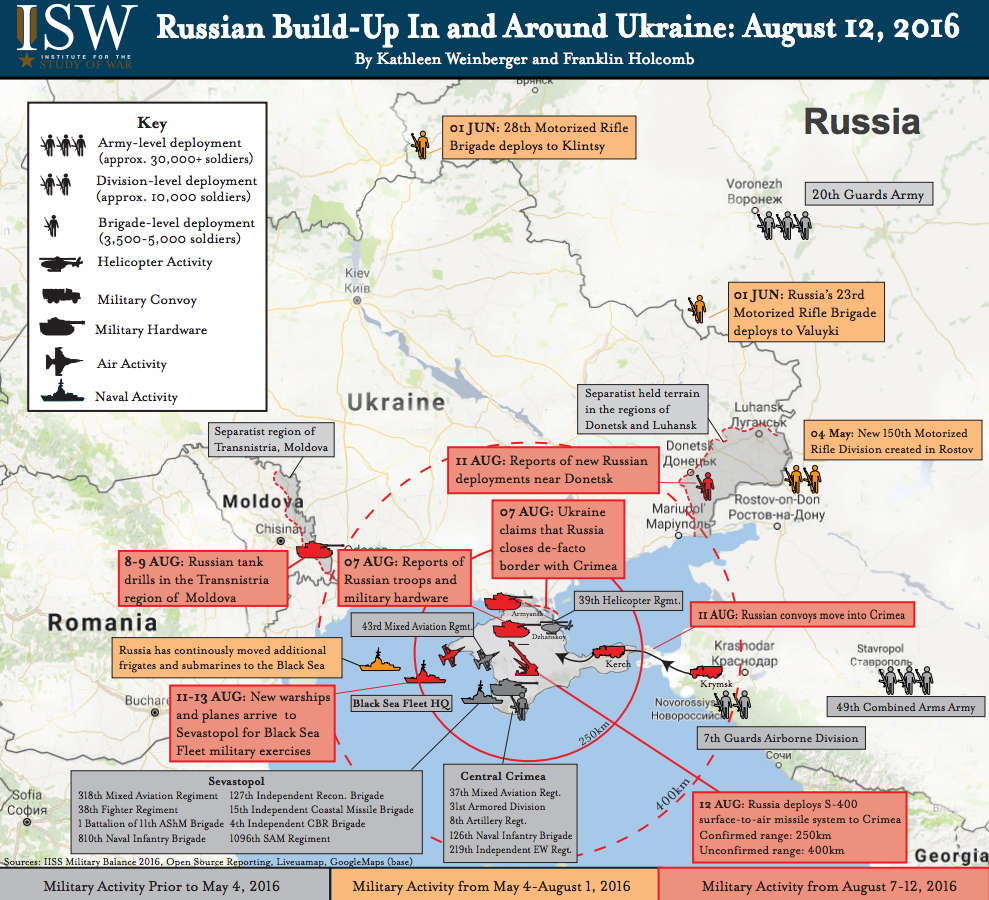The Russian General Staff is not only repositioning these units back where they were before 2009, it’s also rebuilding a capable combat grouping on Crimea — albeit one that’s largely defensive in nature… It also secures the Russian vision for how this conflict ends: In a hypothetical future where the Minsk agreement is actually implemented, Russian forces may withdraw from the separatist enclaves in the Donbass. If the deal fails to hold or Kiev reneges on the terms, Russian divisions ringing the country from its north to very southeast (not including Crimea) would be poised to counter any Ukrainian moves by striking from several directions.
Kofman also sees this strategy as seeking to maintain Russia’s political dominance over Ukraine in the longer term.
The string of divisions, airbases, and brigades will be able to effect conventional deterrence or compellence for years to come… Russia will retain escalation dominance over Ukraine for the foreseeable future. By the end of 2017, its forces will be better positioned to conduct an incursion or threaten regime change in Kiev than they ever were in 2014.
Kofman recommends that the U.S. and its allies carefully think through the implications of this strategy. He believes it will take Ukraine five to 10 years to rebuild an effective military, but even if successful, the future correlation of forces and the aggressive positioning of Russian forces could make the situation more unstable rather than less so.
U.S. policymakers should think about the medium to long term — a timeline that is admittedly not our strong suit. If this conflict is not placed on stable footing by the time both countries feel themselves capable of engaging in a larger fight, it may well result in a conventional war that would dwarf the small set-piece battles we’ve seen so far. Beyond imposing a ceasefire on the current fighting, the West should think about what a rematch might look like several years from now.


What are potential countermeasures Ukraine could invest into in order to survive this (economical) “attrition”? Continuing to give ground?
Defending the steppes is more difficult than lets say the Karelian Isthmus.
This is a good question. In my estimation, the goal of Russian policy is to deter any more Eastern European states from aligning themselves with the West politically, economically, or militarily. The essence of Russian strategy with regard to Ukraine is to coerce the Ukrainians over the short and medium term by leveraging its asymmetrical advantages as economically and sustainably as possible. Putin will avoid overtly invading Ukraine if he can avoid doing so; the economic and political costs would likely destroy his regime. He would run that risk only to prevent Ukraine from joining the West. But he does have certain things he can take advantage of short of war:
• conventional forces superior in number and effectiveness
• effective unconventional and political warfare capabilities
• the presence of disaffected Russian-speaking minority communities along the borders
• a reluctance on the part of the West to provide overt political and military support to Ukraine
• a weak and divided Ukrainian government
• a weak Ukrainian economy dependent on Russia for energy supplies
To counter this Russian strategy, I think Ukraine needs to find ways of raising the costs to the Russians of exploiting their advantages and finding their own asymmetrical openings to exploit.
For example, they can improve the capabilities and capacity of their army in order to raise the costs of military adventurism by the Russians and their proxies in terms of force mobilization and casualties. The Ukrainians could also seek out political and military cooperation with the other Eastern European states facing Russian coercion. Building a border wall would make Russian UW and political warfare more difficult. Crimea and the border enclaves are both wholly economically dependent on Russia; the Ukrainians could probably find ways to make them both more economically burdensome to the Russians. The Russians are dependent upon Ukraine for food just as Ukraine is dependent on Russia for energy.
Fundamentally, however, Ukraine needs to get its own political and economic house in order. The West is highly unlikely to ever intervene on Ukraine’s behalf militarily due to the risks inherent in a direct conflict with the Russians. Consequently, its future as an independent state is likely to depend on how viably it can function independently. But it is likely to face Russian interference for some time to come.
Getting Ukraine’s economy growing is critical to its long term survival. For example, per capita income of Ukraine is $1,854 per person (2016 estimate, based on nominal GDP). Russia is doing much better at $7,742. The Baltic states, also former members of the Soviet Union and now part of NATO and the EU are at $17,000 (the U.S. is $57,220 for comparison). Odessa, which was a booming seaport in the Russian Empire and Soviet Union, has watched a considerable part of its shipping business taken by the Baltic states.
So its survival is dependent on the “mood of the west” and how well Russias economy will fare?
Well, it helps that the Ukrainians have built up their army, but they do need to get their economic house in order and start growing again.